Dionysos
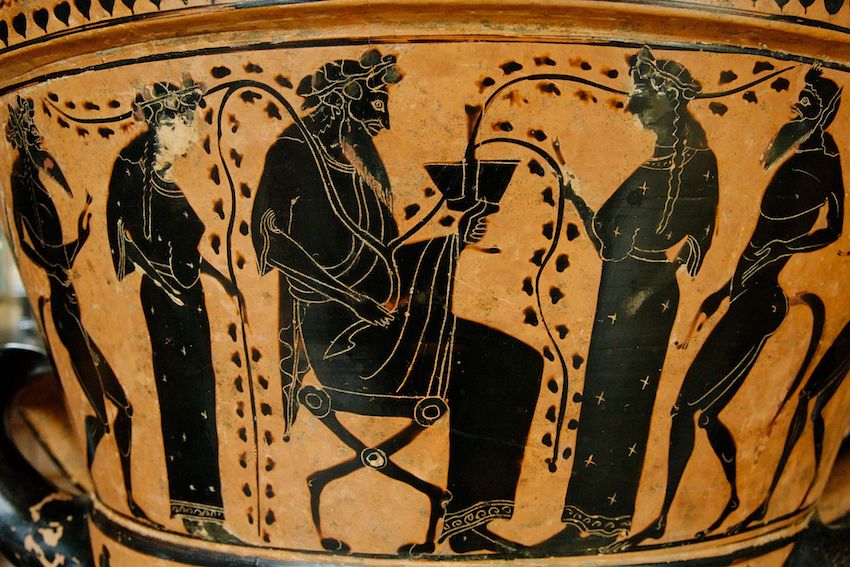
Dionysus and members of his thiasos on an Attic black-figure krater-psykter (525500 BCE, Louvre Museum)
In the most common version, Dionysos' infancy is dominated by the hostility of his father's wife Hera. She provoked the lightning blast which killed Semele, she drove Dionysos' foster parents Ino and Athamas mad, and she continued to persecute him (although never to the extent of his half-brother Herakles).
The response of the two males to this pervasive hostility operates, for the most part, in opposite ways: Herakles must become a virile and potent hero whereas Dionysos is effeminate (although both sometimes display contrary behavior). Just as Hera was inimical to Herakles before his birth (depriving him of his birthright) and during his infancy, Hera harasses Dionysos before his birth and throughout the succession of foster parents to whom he is entrusted by Zeus. A further parallel may be seen between the circumstances of Semele's death and those of Herakles' conception: both events are symbolic portrayals of the sexual prowess of Zeus, whether by extending the night of love-making with Alkmena to three times its normal length or by obliterating Semele with the power of his lightning-bolt.
Indeed, the action of Zeus at the time of Semele's death depicts the contrasting directions which the lives of Herakles and Dionysos will take. One can deal with the threat of the female either by an overwhelming phallic magnitude (the power of the lightning bolt, unendurable by mortals) or by becoming a woman oneself, thereby eliminating the need of a mother, as Zeus does by taking Dionysos into his "male womb" and then "giving birth" to his son himself.
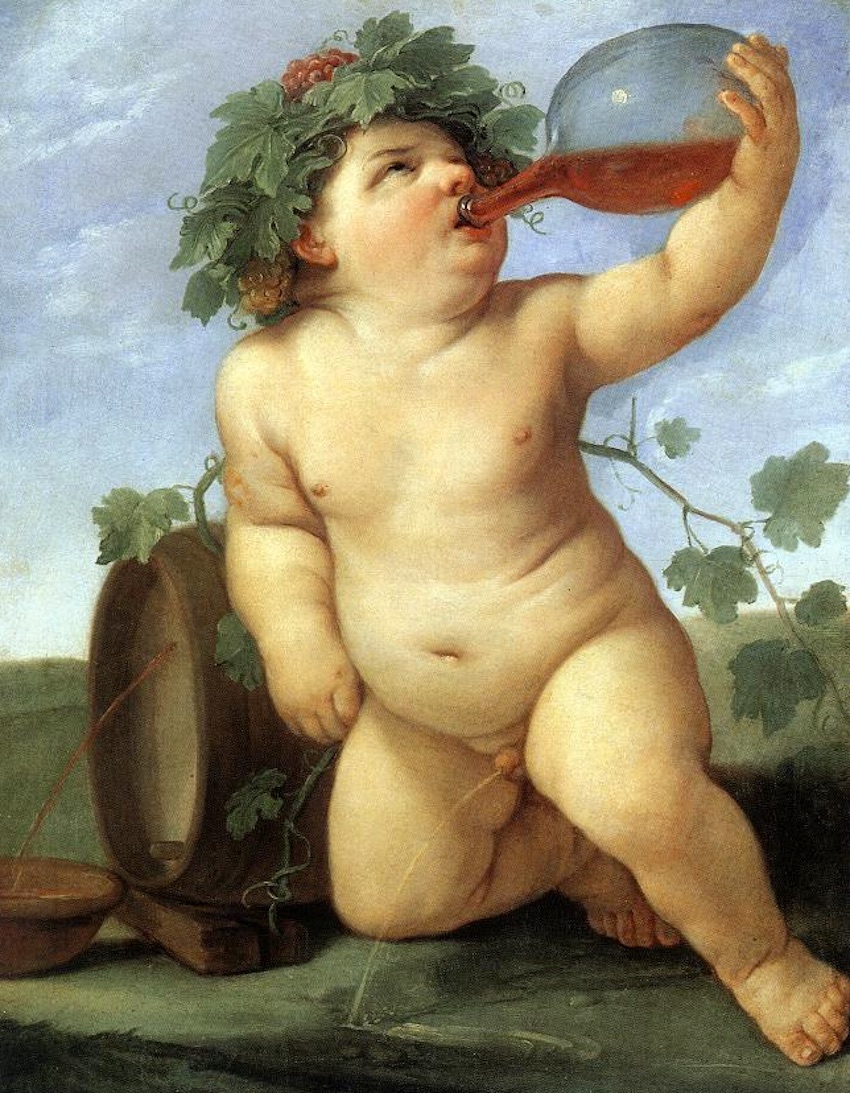
Guido Reni. Drinking Bacchus c. 1623
According to Hyginus, there was no second birth of Dionysos; Hermes snatched the infant Dionysos from the smoldering remains of his mother and gave him to a man named Nysos to raise Pausanias records a version remarkably similar to the nyth of Perseus: according to the people of Brasiai, Kadmos did not believe Semele's claim that her son's father was Zeus, so he put mother and son in a chest and set it adrift; when it floated ashore at Brasiai, the people found Semele dead and raised Dionysos themselves.
Apollonios says that Hermes rescued Dionysos from the flames and took him to Euboia, where Makris (daughter of Aristaios and cousin of Dionysos) moistened his parched lips with honey. Hera banished Makris from Euboia and she went to the island of the Phaiakians, where her cave was to be the place of Iason and Medeia's wedding.
When Dionysos' caretakers were eliminated by Hera and it was no longer possible for him to remain in Thebes, Zeus changed him into a baby goat and had Hermes take him to the nymphs of Nysa, who would later be changed into the stars called Hyades. It seems that a place called Nysa sprang up wherever in the world Dionysos visited, but the earliest mention (in the Iliad) placed Nysa in or near Thrace, and Thrace and Phrygia (northeast Greece and northwest Turkey) are the most common locations.
The young Dionysos was driven mad by Hera, and left his nurses to wander
through Egypt, Syria, and many other eastern lands, These travels were
elaborated by later writers as much as those of Herakles in the west. Herodotus
believed that Dionysos was originally the Egyptian god Osiris, whose worship was
introduced into Greece by the prophet Melampous (who may have learned of it from
Kadmos). According to Diodoros, Kadmos and his daughter Semele lived in
Egyptian Thebes: when Semele had a stillborn, seven-month baby, Kadmos said
that it was an epiphany of Osiris and covered the body with gold plate; later
Orpheus visited the descendants of Kadmos and, having learned of this story,
invented a new one in which Dionysos was the son of Semele and Zeus.
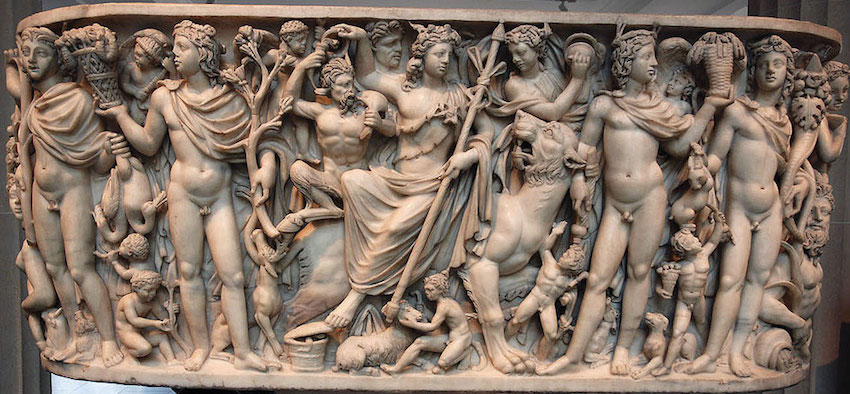
Roman Sarcophagus, Triumph of Dionysos and the Seasons; Stone Sculpture. A.D. 260270. Metropolitan Museum of Art
Diodoros also describes Indian and Libyan versions of Dionysos; in all versions Dionysos begins from a local place called Nysa and proceeds to conquer the entire world, introducing the cultivation of the vine and the knowledge of preserving dried fruits wherever he goes.
In Euripides' Bacchai, Dionysos and his followers claim to have begun their journey in Phrygia and Lydia (western Turkey) and to have travelled through Persia, Baktria, Media, and Arabia. Dionysos also fought and conquered the Amazons of Asia Minor long before the Amazon wars of Herakles and Theseus.
When he came to Phrygia, the indigenous mother-goddess Kybele (whom the Greeks identified with Rhea, mother of Zeus) cured his madness and initiated him into her rituals (which are similar to the Greek rites of the Dionysian religion). Since most modern theories of the origin of the Dionysian religion locate its beginning in Thrace or Phrygia (perhaps first Thrace, then Phrygia, since they are racially related and Thracians moved into Phrygia before the first millennium BC), it is appropriate that Dionysos spends time in both regions before returning to Greece.
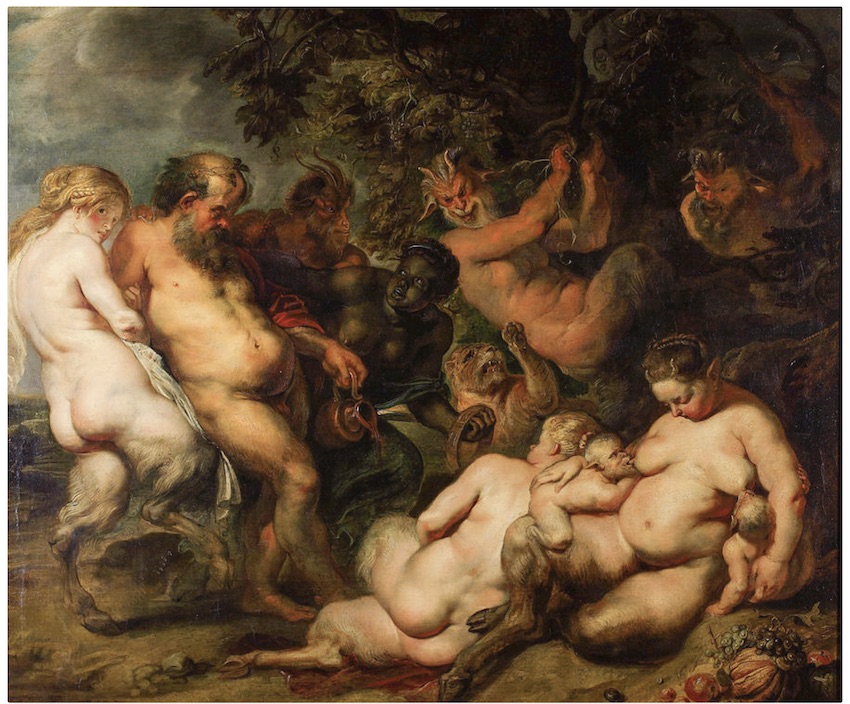
Bacchanalia 1615. Oil on canvas, Puschkin Museum, Moscow
After his cure, Dionysos and his followers began their triumphant return to Greece. Everywhere he went, Dionysos was accompanied by a band of Mainads and Satyrs (whose roles were presumably emulated by locals who subscribed to the new religion). The Mainads (or "Mad Women") were originally his nurses, who were regularly joined by the women of whatever city he came to; they wore flowing eastern garments or animal skins, carried a wand called a thysos (a pole covered with vines and ivy, with a pine cone tip), and celebrated the orgiastic, sometimes hallucinatory, rituals of their god outside the city, in the wilderness or on mountains. In their frenzy they had visions of Dionysos, sometimes appearing as a bull or goat, and they either nursed baby animals (like fawns) or tore them apart with their hands and ate them. As for the Satyrs, they are there because they are of all creatures (with the possible exception of Centaurs) the ones whose sole objective is to be with women who have lost all inhibitions.
Dionysos' first stop after leaving Asia was Edonia in Thrace (northeast Greece), where Lykourgos was king. At first the king drove out Dionysos' followers with an ox-goad, and Dionysos himself escaped into the sea, where he was received by the nymph Thetis. The Nereid nymph Thetis is a notable figure of maternal protection and benevolence; she also rescued Hephaistos when he was thrown from the sky by his mother Hera, and she was a constant source of help and consolation to her son Achilleus.
According to Homer, Zeus punished Lykourgos by blinding him; in other accounts, Dionysos got drunk from wine; he tried to rape his mother, then tried to cut down the vines, but cut off his own foot instead. Or, driven mad by Dionysos, he killed his wife, then killed his son Dryas by cutting off his arms and legs with an axe. Since thier land was barren, the Edonians consulted the oracle and were told that the land would become fertile again only if Lykourgos died. They therefore took Lykourgos to Mount Pangaion, where he was torn apart by horses (or he was killed by the panthers of Dionysos).
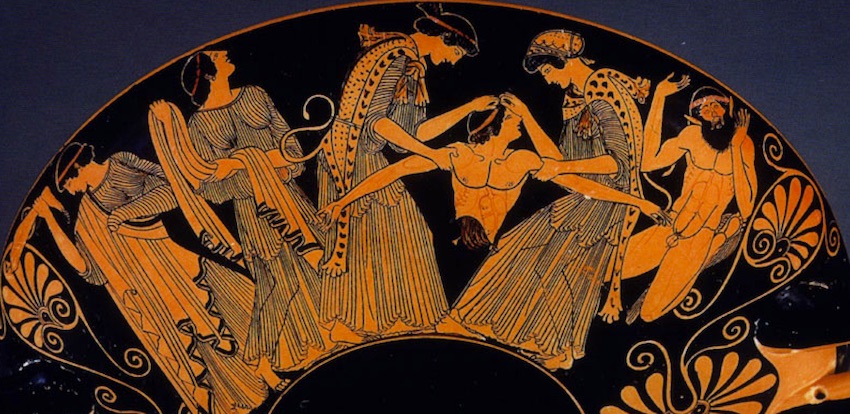
Pentheus torn apart by Ino and Agave, lekanis lid, ca. 450-450 BC, Louvre.
From Thrace Dionysos came to his birthplace Thebes, where he drove the women mad (including his aunts who had denied that Zeus was Semele's lover) and punished king Pentheus (who had opposed his new religion and even imprisoned him) by making him dress as a woman and go to spy on the Mainads. His aunts then tore him limb from limb, and his deluded mother Agave returned to Thebes carrying her son's head on a stick.
In Ovid's account it is not Dionysos but Akoites, a Tyrrhenian pirate who had become a priest of Dionysos, who is captured by Pentheus and miraculously freed, and Pentheus goes to Kithairon not in disguise but in anger.
Dionysos also punished the three daughters of king Minyas of Orchomenos (just north of Thebes) for refusing to participate in his rites; he changed them into bats, or he drove them mad and they devoured Hippasos, son of one of them.
From Thebes Dionysos continued south to Argos, where Proitos was king. Again three dauughters of the king (as at Thebes and Orchomenos) refused to worship him, and he drove them mad.
In another version it was Hera who drove Proitos' daughters mad, because they had insulted her wooden image.
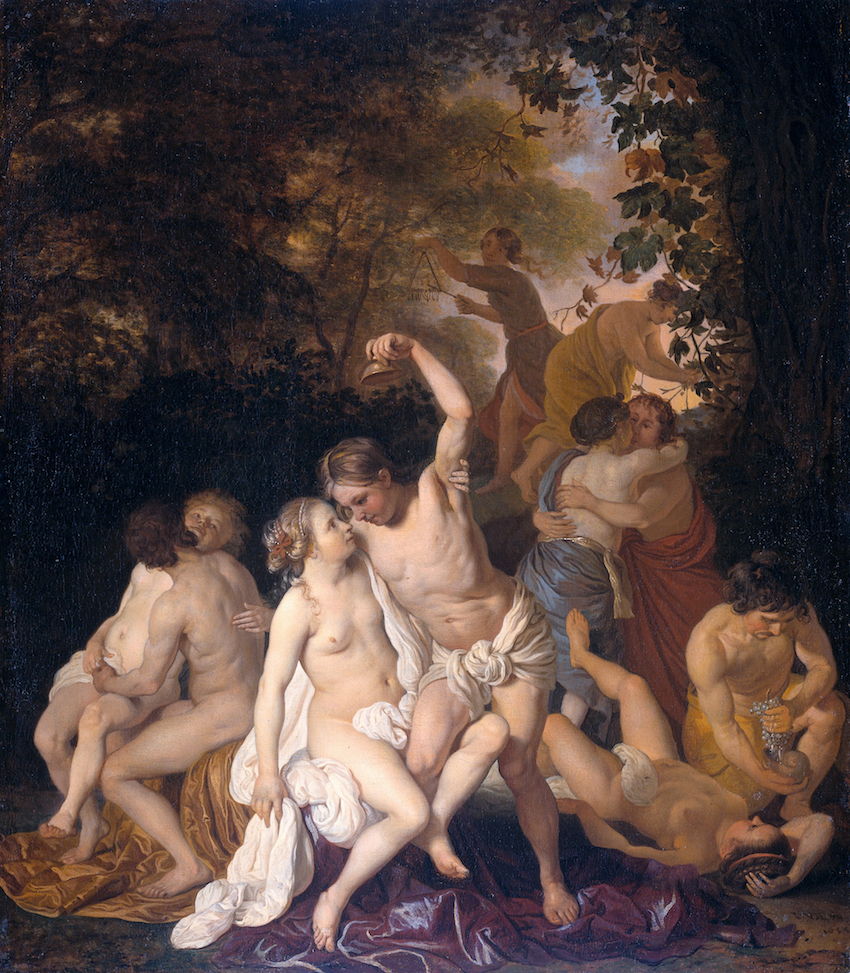
Bacchic Scene, 1653. By Jacob van Loo - www.rijksmuseum.nl
Lysippe, Iphianassa, and Iphinoe, daughters of Proitos and Stheneboia, ran wild through the Arcadian wilderness, imagining that they were cows. The prophet and physician Melampous promised to heal the girls if Proitos gave him a third of his kingdom. When Proitos rejected his offer, the girls' madness increased and furthermore the other women of Argos joined them and they began to eat the infants they were nursing at their breasts. Proitos agreed to pay Melampous' price, but Melampous told him he would have to add another third of the kingdom, for Melampous' brother Bias. Afraid the price would go even higher, Proitos agreed to pay. Melampous took the strongest men of Argos with him and forced the women into a wild and ecstatic dance. Iphinoe, the oldest, died of the cure, but the other women regained their sanity and returned to town, and Proitos' remaining two daughters married Melampous and Bias.
When he came to Athens, Dionysos was entertained hospitably by Ikarios and his daughter Erigone, and in gratitude the god taught them how to grow grapes and make wine. When his first harvest came in, he drove to town and gave some of the local shepherds his new wine. They drank it unmixed, got completely drunk, and fell asleep. When they awoke, they figured they had been poisoned, and so they found Ikarios and beat him to death. Erigone looked everywhere for her father and finally was led to his grave by his dog Maira. Erigone committed suicide by hanging herself from a nearby tree, and the dog also killed itself by jumping into a well.
In retaliation Dionysos drove the girls of Athens mad and they began to hang themselves from trees also. Told what to do by an oracle, the Athenians found and punished the killers and instituted a new festival in Athens, the "Swinging Festival" in which girls imitated Erigone by swinging from trees. This festivel, called the Aiora, was held at dawn on the third day of the Anthesteria, the major spring celebration of the pruning of the vines and the production of wine.
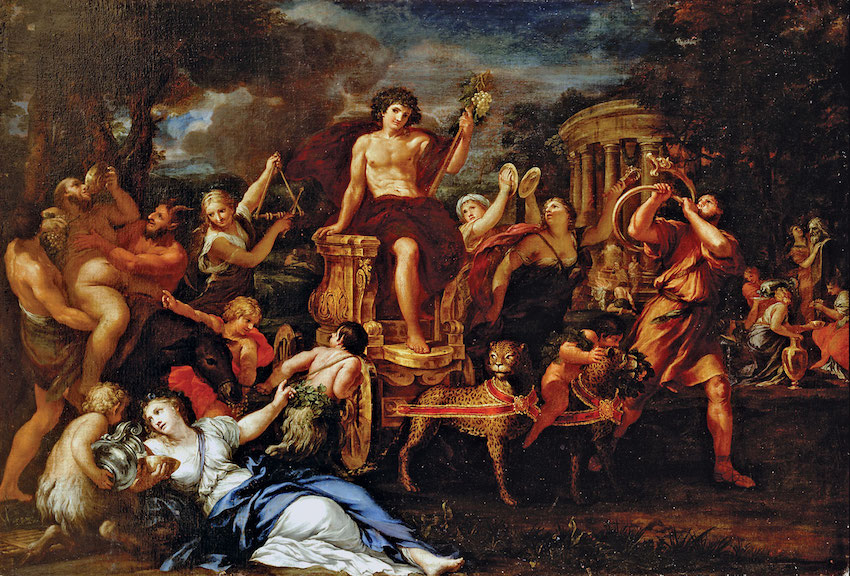
Triumph of Bacchus, oil on canvas by Ciro Ferri, 17th century.
On the west coast of Greece, at Kalydon, lived a couple named Oineus and Althaia. Oineus was known for his hospitality, and even the gods Dionysos and Ares would visit him, since his wife was one of the most beautiful women in the world and, whenever a god would visit, Oineus would find some excuse to go out of town for several days. As a result, Ares and Althaia became the parents of the famous hunter Meleager, and Dionysos and Althaia had a daughter Deianeira, Herakles' second wife. The grateful god gave Oineus (whose name means Wine-Man) the gift of the wine grape; some say that he was the first in Greece to learn this secret.
Several other events in the life of Dionysos happened at indefinite times. At some point, often when he was quite young, he was kidnapped from the island of Ikaria by Tyrrhenian (i.e., Etruscan) pirates, who promised to take him to Naxos but really wanted to hold him for ransom (or fell in love with him because he was so beautiful). The pilot Akoites, who would later become a priest of Dionysos, tried to help him, but was overwhelmed by the crew.
Suddenly the ship stopped dead in the water, the masts and oars were covered with ivy and grape vines, and the silence was broken by the music of flutes. Wild animals appeared on the deck, and the frightened pirates dove into the sea, where they were changed into dolphins.
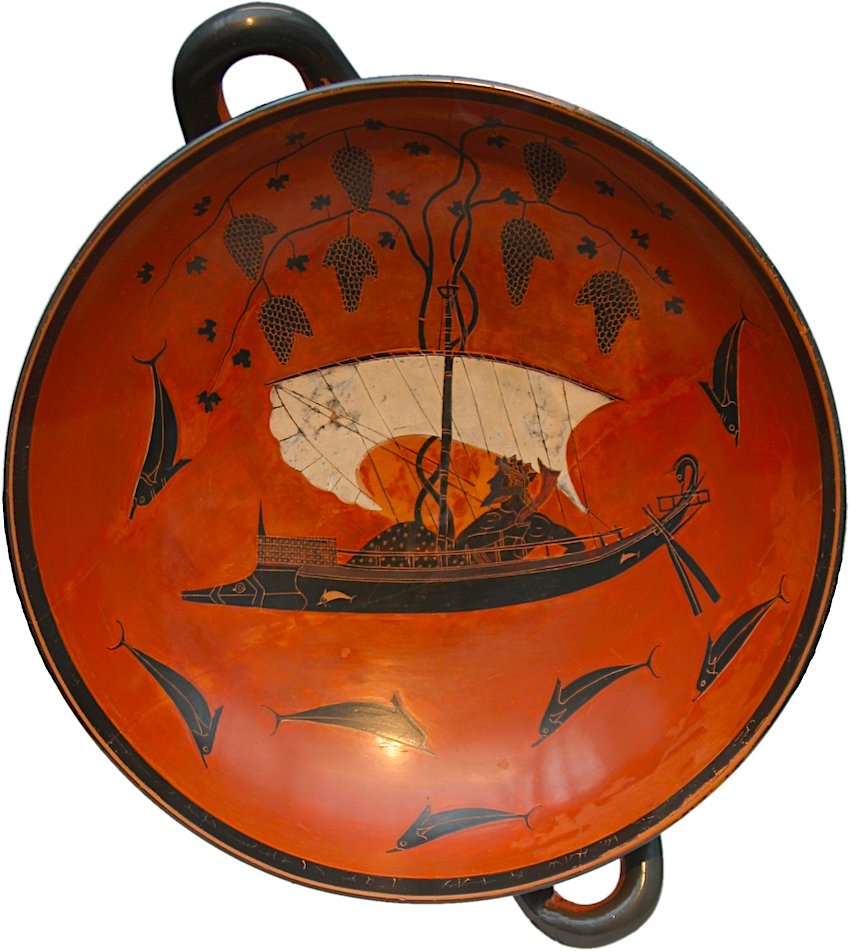
Dionysos. Attic black-figured kylix by Exekias. (Munich, Museum Antikes Kleinkunst.)
At another time Dionysos came to the island Naxos (earlier called Dia) and found Ariadne sleeping. She had been abandoned by Theseus and Dionysos now carried her off and married her (or won her by force from Theseus, or took her from her father Minos in Crete by bribing her with a crown).
Dionysos and his followers (who sometimes appear as an army) also went to Egypt, where he founded a shrine of the god Ammon, and his invasion of India is recounted in a riotous 48-book epic poem called the Dionysiaka by Nonnus of Panopolis, a 5th century AD Egyptian bishop who seems to have seen Dionysos as a precursor to Alexander the Great. During this campaign his companion Seilenos, the oldest and drunkest of the Satyrs, was captured by king Midas of Phrygia, who then returned him to Dionysos. In gratitude Dionysos offered to give Midas anything he wanted, and Midas asked that everything he touched should turn to gold. When Midas discovered that he could not eat golden food, he asked Dionysos to take back the gift. No god can take back what he has given, but Dionysos advised Midas to take a bath in the Paktolos River; thus Midas washed away his gift, and the river from then on was rich in gold.
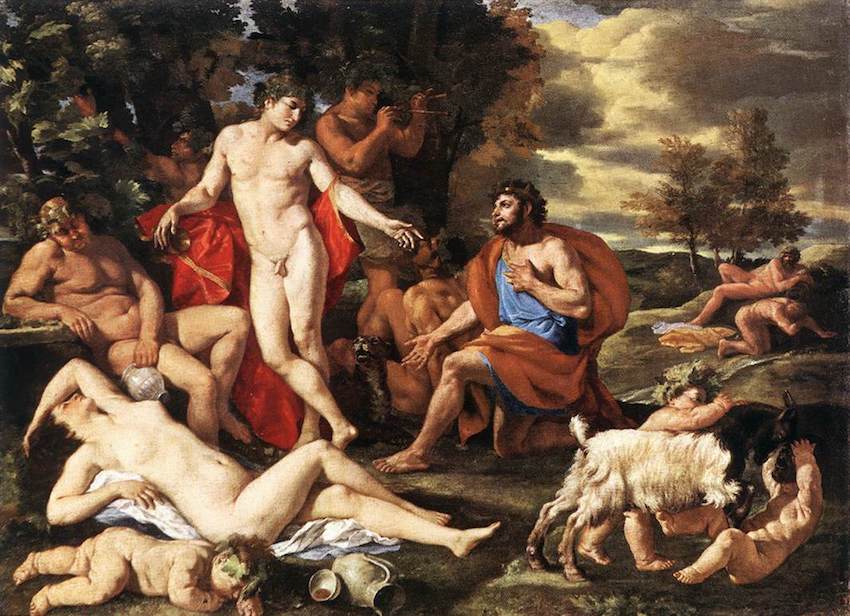
Nicolas Poussin: Midas and Bacchus. Between 1629 and 1630. Alte Pinakothek, Munich
Before he went to Olympos to live among the gods, Dionysos went to Lerna (near Argos) to descend into the underworld and bring back his mother Semele. Since the Dionysian religion apparently offered to its followers some kind of afterlife (the nature of which is completely unknown), it was necessary for the titular god or founder of the religion to go to the underworld and return (to die and come back), like Orpheus or Christ. At Lerna he was shown the way to the underworld by a local guide named Prosymnos, who demanded as pay that Dionysos have sex with him. Dionysos promised to do so when he returned, but when he came back he found that Prosymnos was dead. Dionysos therefore carved a figwood phallus, and and fulfilled his promise by sitting on it. He took Thyone with him to Olympos, where she became a minor goddess with the name Thyone.
Dionysos also played a part in the battle of the gods with the Giants and the battle of Zeus with Typhoeus. In the first he killed the Giant Eurytos with his thyros (wand), and in the second he fled with the other gods to Egypt in fear of Typhoeus, the biggest and meanest monster of Greek myth. In Egypt the gods disguised themselves as animals, and Dionysos took the appearance of a goat.
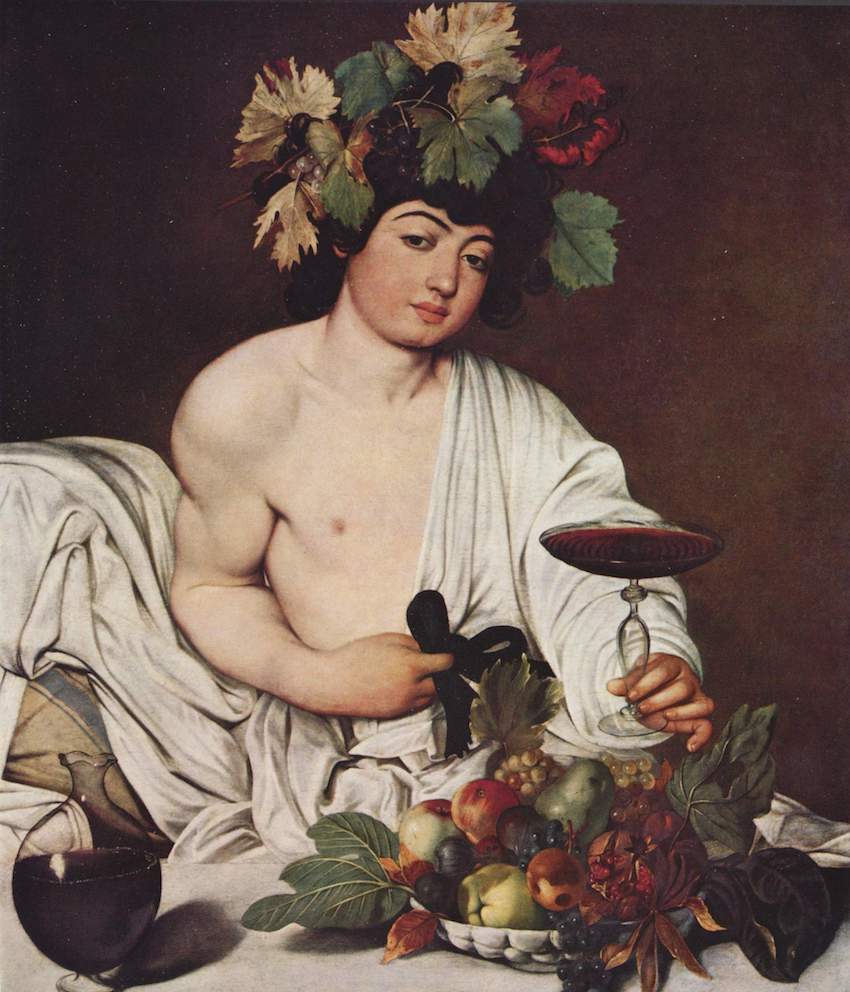
Michelangelo Merisi da Caravaggio: Bacchus. circa 1598. Uffizi Museum
Dionysos is the god of wine, but, more importantly, he also represents an emotional and ecstatic response to the compulsive rationalism which was so important in Greek life and thought. The Delphic maxim "Nothing in excess" has meaning only to a people who were constantly tempted by excess. The Dionysian emphasis on crossing boundaries and surpassing limits in a world where nothing is really what it seems to be helps us to understand why Dionysos was the god of the theater.
Originally associated with Thrace and Phrygia, he came early to Greece
(his name is mentioned in Mycenean tablets of the 13th century BC). There may
well be an element of Minoan religion in his myth and cult (the sparagmos and
omophagia of a bull were important constituents of Minoan cult, as of Dionysian,
and Dionysos himself is often called "Bull" or "Bull-Horned"). But his ongoing
popularity is certainly due to the fact that he is a god of fertility and
sexuality, of That-Which-Is-Different, of that emotional, unreasonable, ecstatic
difference which is missing, for good or bad, from the rest of Greek religion
and philosophy.
